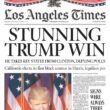April 2018 Update: London-based Epiris private equity is buying Time Inc UK for a reported £125m. The chair will be Sir Bernard Gray, one-time FT journalist, former boss of UBM, TES, Immediate Media, and currently also Chair and co-owner of New Scientist (acquired from Reed Business Information in 2017). Time Inc UK, the former IPC Media has 50 brands (many unprofitable), 30m reader-users but declining revenues of £240m. What brands will be sold off in the streamlining?
25 Sept 2017: Facebook and all those bloggers and vloggers have shredded the magazine market. “Me time” used to describe readers’ relationships with their favourite magazines; now it belongs to social media. For enduring brands, print is becoming ancillary to digital services. Many will still prosper, but magazines are becoming a much smaller business.
That is why even non-investors have been captivated by the grisly sight of the disintegration of the world’s most famous magazine publisher. Time Inc brands illuminated the twentieth century in the US and throughout the world. Almost everybody knows the flagship magazines Fortune, People, Sports Illustrated, and Time itself. But this is the company whose revenue has declined every year since 2011 and has constantly been in the news for its profit warnings, cost cutting – and unsolicited bids for the business.
Time Inc’s share price has virtually halved in the three years since its 2014 IPO. But that much seemed inevitable. As one analyst said at the time: “Every stock needs a dream, something to buy into, but what is the dream here? What this company needs is new ideas, and I haven’t heard any coming out so far.” But parent company Time Warner – which had been rocked by its spectacularly disastrous 2000 merger with AOL – was in a hurry to get rid of the ailing magazine subsidiary.
So, 24 years after its merger with Warner, Time Inc again became an independent company. It began with the first of what have become regular profit downgrades as the decline of print revenues continued to outpace the growth of digital. As recently as 2006, Time Inc was producing profits of $1bn. By last year, this had fallen to $400m and it will be even lower in 2017.
The performance has turned off investors and prompted ever-louder demands to sell-up. A reluctant sale process this year was aborted by a newly-confident management team who are now using McKinsey consultants to guide the company’s “re-engineering”. But the financials keep getting worse. The latest Time Inc sideshow is the auctioning of “selected assets” said to account for about $488m or 17% of total Time Inc revenues. By far the largest of these proposed divestments is Time Inc UK, which – until just three years ago – was known as IPC Media. They’re not ready for it.
The UK subsidiary – like its US parent – has been trumpeting an illusory “transformative success”. The publisher of a mixed bag of 50 magazines, including Country Life, Marie Claire UK, What’s On TV, Wallpaper, Ideal Home, Horse & Hound, Yachting World, Uncut, Cycling Weekly, Chat, Decanter and Woman & Home, last year hailed its 2015 results as a “significant milestone in the turnaround of the company”. But the figures were clouded by the bonanza £415m sale of the company’s landmark headquarters.
The reality is that operating profit (including heavy reorganisation costs) totalled just £14m – 50% down since 2012 on £260m revenues that had declined by 17%. Profit margins which had been a meagre 9% in 2012, had fallen to just 5%. And most of the UK profits had been swallowed up by a gaping hole in the company’s pension scheme.
The profit slide has cast a long shadow over a company which has dominated UK media for much of the last 50 years. IPC (the International Publishing Corporation) had been formed in 1963 by the merger of three competing companies – Odhams, Newnes, and Fleetway – which later added the Daily Mirror newspapers. IPC became almost a monopoly of UK magazines and popular newspapers.
It was once the publisher of more than 100 magazines, including the country’s four hugely-profitable women’s weeklies together selling some 8m copies. It had magazines across almost every sector, and also business information, newspapers, books, children’s comics, and printing plants. It then became part of the Reed International (later Reed Elsevier) conglomerate, then with sprawling interests across the manufacture of paper, paint and building materials. But serious competition arrived in the 1980s, prompted by new full-colour printing presses, the rapid growth in advertising revenue – and IPC’s own monopoly profits.
Competitive magazines started to come thick and fast, through the expansion of then UK regional publisher EMAP, BBC launches of TV-linked magazines, the arrival of German publishers Gruner & Jahr and Bauer, and the expansion of US-owned Hearst and Conde Nast. It became easy to lampoon IPC as the “Ministry of Magazines” – bigger, richer and slower-moving than its newer, more agile competitors. But it was also the publisher which gave British readers Loaded, Look, Now, Look & Learn, the imported Marie Claire and In Style, and the market’s steadiest presence Country Life.
‘Milked’ by its owners
But, gradually, the new product development slowed up as IPC was milked for profits, first by Reed and then by the Cinven private equity firm which bought it in 1998 for £860m. That was when the company was making £70m profits from £350m revenues. In the sale prospectus, IPC boasted about its market and innovation leadership, having launched its first four “internet sites”. Even then, that didn’t look very impressive.
The real story, though, was that the magazine group’s profit growth for the previous five years had been juiced-up by cost-cutting and minimal R&D funding, not by revenue growth or innovation. Even the modest revenue increases had camouflaged the company’s aggressive cover price increases. Tellingly, operating profit margins had leapt from 17% to 22% during that run-up to the auction by Reed Elsevier. But private equity bought the story – and actually made another killing. Three years later, after having flirted with the whizzy dotcom idea of merging IPC with thought-to-be digital wunderkind Future Plc, Cinven managed to sell the business for £1.15bn (a gain of 35%). The 2001 purchaser was one Time Warner, which had merged a year earlier with AOL. The AOL-Time Warner merger was still being hailed as a perfect marriage of new-old media, with the full scale of the disastrous dotcom deal yet to be admitted. And Time-IPC in the UK was also considered to be a pretty smart move – but not by everyone.
Time Inc itself had, for over 60 years, been a different kind of magazine publisher. Its portfolio was those major weeklies. It had become the largest US magazine publisher by flying high above the hyper-competitive and fragmenting markets for women’s and specialist magazines. Some good folks at Time Inc clearly did not quite see it that way. In 1995, they paid a then publishing record $498m for Alabama-based Southern Progress, which brought magazines like Southern Living, Coastal Living, and This Old House. That entry into the ‘new’ world of niche magazines led directly to the acquisition of IPC six years later.
But while the original stable of Time Inc weekly magazines had seemed to offer synergies with Time Warner’s core film and cable TV businesses, special interest and women’s ‘service’ magazines in the US and UK were always a stretch. The IPC acquisition was promoted by Time Inc chairman Don Logan, who had himself joined the company along with Southern Progress. So he was all over a strategy to publish lots of magazines all over the world and made IPC’s executives feel right at home. In 2001, he said: “This is the perfect acquisition for AOL Time Warner because it accomplishes key strategic goals for the company. With some of the best-known consumer publishing brands in Europe, IPC provides Time Inc with an important presence in the European consumer publishing sector. This acquisition also furthers AOL Time Warner’s goal of expanding our operations outside of the US.”
But the unbridled enthusiasm for magazines large and small – did not survive the quick succession of executives then drafted in to unravel the AOL fiasco – subsequently described by Time Warner chairman Jeff Bewkes as “the biggest mistake in corporate history”. He thought the UK magazine deal was pretty dumb too.
Today, Time Inc UK is
- 50 magazines read by almost 40% of the UK population
- Web sites used by more than 25m global users each month
- £250m turnover
- 1,500 people
The CEO is Marcus Rich, a highly-rated executive with a background in magazines, newspapers, and advertising agencies in the US, Australia and the UK. His energetic three years at the helm of the former IPC have been characterised by: decentralisation into three London offices and one in rural Hampshire; £20m of bolt-on acquisitions, notably in events; the launch of TV/video production; and steady, if not spectacular, digital growth. He turned the veteran music weekly NME into a 300,000-circulation free magazine, although nobody is yet crowing about its success.
Rich is effusive about his company’s progress and a fierce advocate of magazines as durable advertising media: “I’m very positive. At the very heart of the business, you have something very unique – you have a relationship with the consumer that other platforms don’t have.” But, as a typical UK publisher vulnerably dependent on retail sales not subscriptions, the CEO would kill to get his hands on the powerful user data generated by those digital platforms.
The trouble is that – unlike at least some newspapers – few magazines can survive without advertising, and the loss of those colourful paid-for pages actually turns off readers. So, for all Rich’s articulacy, mass market magazine profits seem destined to keep shrinking. And his own sprawling company is no better placed than any other to cope with the suffocating rush of digital media.
For a start, Time Inc UK is over-staffed. In spite of a 14% reduction in people over the past four years, its 1,519 workforce (as at end-2015) is some 50% larger than any other UK magazine company. It has the lowest revenue per head of the five largest publishers – well behind the smaller but more profitable Bauer and Immediate. As if to reinforce the lacklustre performance, Time Inc UK has spent no less than £35m on reorganisation and redundancy costs over the past three years. Even if you strip out the £3.5m compensation paid to ousted directors, the average cost of each job saved has been £130k, equivalent to more than two years’ average salary.
Such generosity is good news for more than just the recipients of Time Inc’s largesse. Would-be buyers will see the numbers as a wide-open opportunity to achieve a step-change in costs and profitability.
Magazines can still work
A company called Exponent might just be licking its lips. It is the media-savvy private equity investor which scored a total return of some four times its investment when it sold Immediate Media (largely the former BBC Magazines) to Burda for £300m+ in 2016 after five years of ownership.
That deal is a reminder that magazines can still be an attractive business: the ex-BBC publisher made profits of £35m on revenue of £150m (a profit margin almost five times that of Time Inc UK). Immediate’s main London company has a workforce one-third that of Time Inc UK, per capita revenue is 40% higher, and average staff costs are 15% lower.
But Time Inc UK has other problems. It might be the publisher of lots of weekly and monthly magazines but even some of its better known brands are loss-makers whose continuation owes more either to their contribution to fixed central overheads or to the unwanted costs that would be incurred in closing them. And, like so many traditional publishers, few of the web sites touted as “digital properties” could ever become businesses in their own right. Most are ancillary to magazine brands and may, therefore, decline with the printed editions.
Time Inc’s single most profitable UK magazine has consistently been the 885k-circulation weekly What’s On TV. It once accounted for almost 50% of total UK profits. But that was five years ago when copy sales were 30% higher.
The company, with TV Times (177k circulation), has a 30% share of the TV listings market which sells 3m copies per week and remains a rich, if surprising, seam of UK profit, also for Bauer (TV Choice) and Immediate Media (whose Radio Times accounts for more than 50% of its profit). But even this sector (which so recently accounted for 4m copy sales per week) is also on the slide. All TV listings magazines have declined this year, with circulations variously cut by 3-10%.
That might trouble some would-be buyers. But many will also consider that the sheer scale of the Time Inc UK portfolio and the number of small and marginal magazines is the opportunity – providing they make the change. They need to be able to drill-deep into key markets rather than struggle to exploit a randomly broad portfolio.
The likely strategy for any buyer (including private equity firms like the UK-based Epiris which is believed to be involved in talks and would probably retain the existing management team) will include a requirement to:
- Focus on audience groups and special interest sectors in order to develop multi-channel strategies including e-commerce, paid-for information, membership clubs, and events. Magazines are just part of the mix
- Divest unwanted magazines and target rival brands for swaps in order to generate additional profits
- Sharply reduce overheads, especially the current 15% of “administrative” staffing
A new owner of Time Inc UK might project a slimmed-down business with some £150m revenues, 750-1000 people and perhaps £25m in pre-tax profits. If it gets there, the company might have a market value of £150m, depending on growth rates and the extent of digital and events revenues. But getting anywhere near that would also involve substantial restructuring and one-off expenditure (net of proceeds from divestments) of perhaps £50m. With this cost and the <£100m of unfunded pension liabilities, Time Inc may actually have to offer buyers a ‘dowry’ to ensure it can sell the business at all. That’s how much things have changed for magazines and for the once-formidable UK market leader.♦




